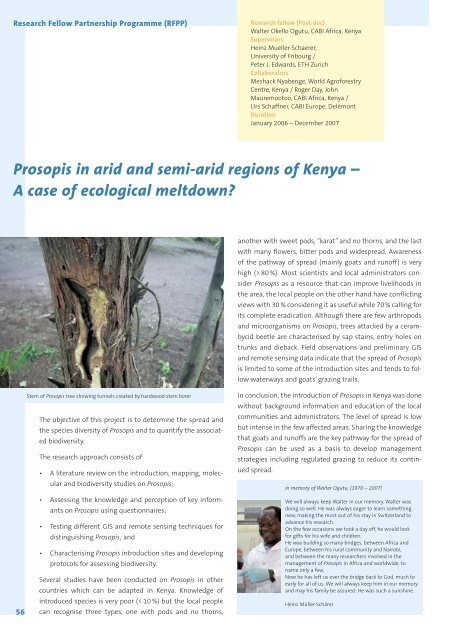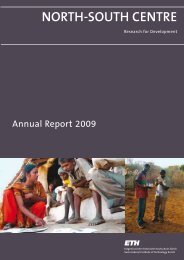Research Fellow Partnership Programme (RFPP)Research fellow (Post-doc)Walter Okello Ogutu, CABI Africa, KenyaSupervisorsHeinz Mueller-Schaerer,University of Fribourg /Peter J. Edwards, <strong>ETH</strong> ZurichCollaboratorsMeshack Nyabenge, World Agroforestry<strong>Centre</strong>, Kenya / Roger Day, JohnMauremootoo, CABI Africa, Kenya /Urs Schaffner, CABI Europe, DelémontDurationJanuary <strong>2006</strong> – December 20<strong>07</strong>Prosopis in arid and semi-arid regions of Kenya –A case of ecological meltdown?another with sweet pods, “karat” and no thorns, and the lastwith many flowers, bitter pods and widespread. Awarenessof the pathway of spread (mainly goats and runoff) is veryhigh (> 80 %). Most scientists and local administrators considerProsopis as a resource that can improve livelihoods inthe area, the local people on the other hand have conflictingviews with 30 % considering it as useful while 70 % calling forits complete eradication. Although there are few arthropodsand microorganisms on Prosopis, trees attacked by a cerambycidbeetle are characterised by sap stains, entry holes ontrunks and dieback. Field observations and preliminary GISand remote sensing data indicate that the spread of Prosopisis limited to some of the introduction sites and tends to followwaterways and goats’ grazing trails.Stem of Prosopis tree showing tunnels created by hardwood stem borerThe objective of this project is to determine the spread andthe species diversity of Prosopis and to quantify the associatedbiodiversity.The research approach consists of• A literature review on the introduction, mapping, molecularand biodiversity studies on Prosopis;• Assessing the knowledge and perception of key informantson Prosopis using questionnaires;• Testing different GIS and remote sensing techniques fordistinguishing Prosopis; and• Characterising Prosopis introduction sites and developingprotocols for assessing biodiversity.Several studies have been conducted on Prosopis in othercountries which can be adapted in Kenya. Knowledge ofintroduced species is very poor (< 10 %) but the local people56 can recognise three types, one with pods and no thorns,In conclusion, the introduction of Prosopis in Kenya was donewithout background information and education of the localcommunities and administrators. The level of spread is lowbut intense in the few affected areas. Sharing the knowledgethat goats and runoffs are the key pathway for the spread ofProsopis can be used as a basis to develop managementstrategies including regulated grazing to reduce its continuedspread.In memory of Walter Ogutu, (1970 – 20<strong>07</strong>)We will always keep Walter in our memory. Walter wasdoing so well. He was always eager to learn somethingnew, making the most out of his stay in Switzerland toadvance his research.On the few occasions we took a day off, he would lookfor gifts for his wife and children.He was building so many bridges, between Africa andEurope, between his rural community and Nairobi,and between the many researchers involved in themanagement of Prosopis in Africa and worldwide, toname only a few.Now he has left us over the bridge back to God, much toearly for all of us. We will always keep him in our memoryand may his family be assured: He was such a sunshine.Heinz Müller-Schärer
Research fellowApollin Fotso Kuate, IITA CameroonSupervisorsPeter Nagel, University of Basel /Rachid Hanna, IITA, BeninCollaboratorsMaurice Tindo, IITA, Cameroon /Georg Goergen, IITA, BeninDurationNovember <strong>2006</strong> – October 2009Research Fellow Partnership Programme (RFPP)Options for controlling African root and tuber scaleon cassava in Central Africa – Understanding theecology of the associated ant Anoplolepis tenellaAnoplolepis tenella is an afro-tropical ground-dwelling antspecies with widespread distribution in the forest zones ofCentral Africa, where it is largely found in association withthe African Root and Tuber Scale (ARTS) Stictococcus vayssiereiRichard, an emerging pest of cassava in Central Africa. Amajor effort is presently underway to identify factors thataffect the abundance of ARTS, and to develop sustainablepractices for its management on cassava and other affectedfood crops. While the nature of the interactions betweenA. tenella and ARTS is not well-understood, present evidencesupports the hypothesis that the scale needs the ant toremove its honeydew secretions, otherwise the scale woulddrown in its own secretions; and most likely to move crawlerswithin and between plants. As ARTS cannot survive withoutA. tenella, management options that disrupt scale-ant associationwould be most effective in controlling damagingscale populations. Such efforts, however, require solidand sufficient understanding of the biology and ecology ofA. tenella and its impact on ARTS life cycle and ecology.We will first determine the effect of habitat characteristics(e.g., vegetation, temperature, humidity, rainfall, co-occurringant diversity, abundance of ARTS and other ant-tendedhomopteran insects) on patterns of A. tenella distributionand abundance in <strong>South</strong>ern Cameroon, where ARTS distributionis well known. Secondly, we will determine the level andnature of interactions between A. tenella and co-occurringant species, assess their impact on ARTS development andsurvivorship, and conduct farmer-participatory trials toevaluate the effects of ant exclusion on ARTS abundance anddamage severity on cassava. In a third component, we willdetermine the role of A. tenella workers and queens in ARTSdispersal.Findings from this project will feed into IITA’s cassava, IPM andbiodiversity projects, and the biogeography programmes ofthe University of Basel, with the broad aim of developing sustainablepractices to reduce ARTS infestation on cassava, anddocumenting and conserving biodiversity in Central Africa.Cassava cutting infested with Stictococcus vayssierei57
- Page 1 and 2:
Swiss Centre for International Agri
- Page 3 and 4:
Table of contentsZIL members. . . .
- Page 5 and 6:
EditorialThe present Annual Report
- Page 7 and 8: An introduction to ZILThe ZIL proje
- Page 9 and 10: An introduction to ZILThe Progress
- Page 11 and 12: An introduction to ZILOn September
- Page 13 and 14: An introduction to ZILIn 2007, the
- Page 15: An introduction to ZILThe ZIL Execu
- Page 18 and 19: Impact StudyThe development impact
- Page 20 and 21: Impact Study18market opportunities
- Page 22 and 23: Impact Study20ral (N), human (H), f
- Page 24 and 25: ERA-ARDThe European Research Area i
- Page 26 and 27: ZIL research projectsOverviewLivest
- Page 28 and 29: ZIL research projectsIntegratedPest
- Page 30 and 31: ZIL research projectsEcosystemservi
- Page 32 and 33: ZIL research projectsLivestocksyste
- Page 34 and 35: ZIL research projectsLivestocksyste
- Page 36 and 37: ZIL research projectsLivestocksyste
- Page 38 and 39: ZIL research projectsLivestocksyste
- Page 40 and 41: ZIL research projectsLivestocksyste
- Page 42 and 43: ZIL research projectsLivestocksyste
- Page 44 and 45: Research Fellow Partnership Program
- Page 46 and 47: Research Fellow Partnership Program
- Page 48 and 49: Research Fellow Partnership Program
- Page 50 and 51: Research Fellow Partnership Program
- Page 52 and 53: Research Fellow Partnership Program
- Page 54 and 55: Research Fellow Partnership Program
- Page 56 and 57: Research Fellow Partnership Program
- Page 60 and 61: Research Fellow Partnership Program
- Page 62 and 63: Research Fellow Partnership Program
- Page 64 and 65: Seed MoneySeed Money Projects 2003-
- Page 66 and 67: Other international projects of ZIL
- Page 68 and 69: Teaching activities related to deve
- Page 70 and 71: Development-related thesesSupervisi
- Page 72 and 73: Development-related thesesSuperviso
- Page 74 and 75: PublicationsPublications72Refereed
- Page 76 and 77: PublicationsMathayya, S., Thankacha
- Page 78 and 79: PublicationsVariaZIL funded project
- Page 80 and 81: PublicationsRFPP projectsAbang, M.,
- Page 82 and 83: PublicationsStupak, M., Alder, A.,
- Page 84 and 85: PublicationsStickstoffumsatz und di
- Page 86 and 87: PublicationsOther international pro
- Page 88 and 89: Publicationssubandinen Waldweide-Sy
- Page 90 and 91: ZIL members, collaborators and part
- Page 92 and 93: ZIL members, collaborators and part
- Page 94 and 95: AccountsAccounts 2006*Balance, Dece
- Page 96: Swiss Centre for International Agri
















